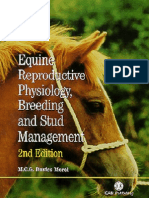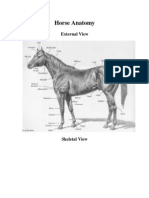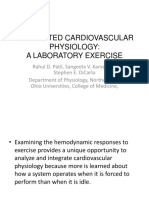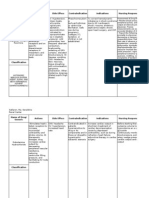The Equine Cardiovascular System
The Equine Cardiovascular System
Uploaded by
Savannah Simone PetrachenkoCopyright:
Available Formats
The Equine Cardiovascular System
The Equine Cardiovascular System
Uploaded by
Savannah Simone PetrachenkoCopyright
Available Formats
Share this document
Did you find this document useful?
Is this content inappropriate?
Copyright:
Available Formats
The Equine Cardiovascular System
The Equine Cardiovascular System
Uploaded by
Savannah Simone PetrachenkoCopyright:
Available Formats
The Cardiovascular System (Part 3)
The Path of a Red Blood Cell Left ventricle Aorta Systemic circulation Vena cava Right atrium Right ventricle Pulmonary artery Pulmonary circulation Pulmonary vein Left atrium
Pulmonary Circulation Deoxygenated blood is delivered to the lung by the pulmonary artery. The pulmonary artery divides into left and right and then divides into lobar arteries within the lung
into lobar arteries within the lung Blood passes through the capillary bed and is oxygenated Oxygenated blood is delivered to the heart by the pulmonary vein Systemic Circulation Arterial component Aorta Coronary arteries Thoracic aorta Brachiocephalic trunk Abdominal aorta Venous component Cranial vena cava Drains head, neck, thoracic limbs, thorax Caudal vena cava Internal and external iliac veins Portal system Hepatic system is where the portal vein divides again in to a second bed of capillaries within the liver
Fetal Circulation The fetus depends on the mare for nutrients, water, oxygen, and for elimination of waste
for elimination of waste The lungs aren't functional until the neonate takes its rst breath The fetal circulation essentially bypasses the pulmonary system
Umbilical arteries To the placenta Umbilical vein From the placenta Ductus venosus Delivers oxygenated blood directly to the vena cava of the fetus Foramen ovale Between left and right atrium Bypasses the lung Ductus arteriosus Connects the pulmonary trunk and the aorta Bypasses the pulmonary arteries Electrical Activity of the Heart Similarly to skeletal muscle, to trigger movement, each cardiac cell requires an action potential at the cell membrane This brings about the release of calcium, causing contraction of the muscle bers and depolarization Measuring Electrical Activity Electrocardiography Recording electrodes are placed on the surface of the body in specic sites (also called "leads) Patterns of electrical activity (rhythm) are recorded
"Arrhythmia" = abnormality of electrical activity Cardiac Muscle Cardiac muscle is NOT innervated by a motor neuron The action potential is regulated by a specialized coup of cells found in the sinoatrial node (SA node) The SA node propagates the signal to contract via the intercalated discs The Sinoatrial (SA) Node Is called the pacemaker of the heart It can spontaneously develop an action potential and communicate to all myocardial cells to produce a CONTRACTION! Also uses other specialized cells in the "AV node" and purkinje bers to delay signal to ventricles What changes the heartbeat? Combination of innervation (to SA and AV) from the autonomic (non voluntary) nervous system Sympathetic In the excited horse - increases heart rate Parasympathetic In the relaxed horse - decreases heart rate Cardiac Output (CO) Volume of blood pumped by the ventricle over a given period of time CO = Heart Rate x Stroke Volume Stroke Volume: how much blood is in the heart before it contracts? Can be changed by: Filling of the ventricle (end diastolic volume) Contractility of the heart muscle Filling the ventricle with blood... Depends on: Filling pressure from the veins and atrium Directly related to blood pressure in the veins and blood volume Ability for the ventricle to relax and stretch Size of heart ventricles Elasticity of myocardium Secretariat the Racehorse His heart weighed close to 22 pounds The average thoroughbred heart weighs 9 pounds Increased ability to pump blood to the body and limbs In a normal-sized heart - what effects the ventricular lling?
Many factors... When there is venous constriction, there is an increase in the rate of ventricular lling When the heart rate is slow, there is an increase in the time for the ventricle to ll Contractility of Heart Muscle Affected by neurotransmitters of the autonomic nervous system E.g. Epinephrine Increases cardiac contractility by binding to receptors and increasing Ca+ in muscle cells In Summary The cardiac output of the horse is regulated by: Heart Rate Stroke Volume Filling of the ventricle (venous pressure + volume) Contractility of heart muscle (A.N.S.) Cardiovascular health and tness can be assessed by: Heart rate Heart rhythm Ability of the myocardium to contract Blood pressure in the venous system Blood Pressure Affected by the physiology of the microvasculature Arteries Veins Capillary beds Anatomy of the Blood Vessel Arteries and veins have 3 layers: Tunica interna Tunica media Tunica externa All are lined by endothelium (simple squamous epithelium)
Arteries Much thicker tunica media Contains smooth muscle Elastic arteries - special type that have elastic properties for expansion and contraction during the cardiac cycle Aorta Veins Also have smooth muscle Some veins below the level of the heart have ap-like valves to promote one-way ow of venous blood back to the heart Blood Pressure
Blood pressure is inuenced by: Peripheral resistance Arteries and veins Highest in the arterioles Blood volume Effects cardiac output Nervous system
Sympathetic and parasymethatic Receptors in the aorta, atrium Endocrine system Kidney enzyme renin MAP = CO x TPR During Exercise... The horse has an increased need for cardiac output and blood ow to skeletal muscle Increase in heart rate Vasodilation of arterioles in muscle Vascular resistance in other organs
You might also like
- Nursing Cheat Sheets 76 Cheat Sheets For Nursing Students - Nodrm PDFDocument100 pagesNursing Cheat Sheets 76 Cheat Sheets For Nursing Students - Nodrm PDFAnnissa Larnard97% (63)
- Equine Exercise PhysiologyDocument456 pagesEquine Exercise PhysiologyWilson Faria100% (1)
- Introduction To Equine Anatomy and PhysiologyDocument8 pagesIntroduction To Equine Anatomy and PhysiologySavannah Simone Petrachenko100% (2)
- 2018 Equine Flash CardsDocument191 pages2018 Equine Flash CardsGABRIEL MEDEIROSNo ratings yet
- EFCCSSUDocument785 pagesEFCCSSUchepebetosm100% (3)
- Equine OphthalmologyDocument477 pagesEquine OphthalmologyLessana de Moura GonçalvesNo ratings yet
- Philips MX 550Document20 pagesPhilips MX 550aal100% (1)
- Proceedings of The 54th Annual Convention of The American Association of Equine PractitionersDocument4 pagesProceedings of The 54th Annual Convention of The American Association of Equine PractitionersJorge HdezNo ratings yet
- 01 Body Conformation of HorseDocument32 pages01 Body Conformation of HorseDrSagar Mahesh Sonwane100% (4)
- Corrective Shoeing of Equine DenoixDocument9 pagesCorrective Shoeing of Equine DenoixEduardo JaraNo ratings yet
- Equine Radiographic AnatomyDocument32 pagesEquine Radiographic AnatomySam Bot100% (2)
- Equine Reproductive Physiology, Breeding, and Stud ManagementDocument383 pagesEquine Reproductive Physiology, Breeding, and Stud Managementfrancisco_aguiar_22100% (2)
- The Equine Estrous CycleDocument2 pagesThe Equine Estrous CycleSavannah Simone PetrachenkoNo ratings yet
- Equine MusclesDocument6 pagesEquine MusclesSavannah Simone PetrachenkoNo ratings yet
- The Equine FootDocument4 pagesThe Equine FootSavannah Simone PetrachenkoNo ratings yet
- The Equine Respiratory SystemDocument13 pagesThe Equine Respiratory SystemSavannah Simone PetrachenkoNo ratings yet
- The Equine Cardiovascular SystemDocument5 pagesThe Equine Cardiovascular SystemSavannah Simone PetrachenkoNo ratings yet
- 1-Equine Digestion PowerPointDocument15 pages1-Equine Digestion PowerPointMazhar FaridNo ratings yet
- Color Atlas of The Horses Foot CompleteDocument210 pagesColor Atlas of The Horses Foot CompleteMax MaxNo ratings yet
- The Equine IntegumentDocument4 pagesThe Equine IntegumentSavannah Simone PetrachenkoNo ratings yet
- TNH6000Document7 pagesTNH6000Jonathan LiNo ratings yet
- Equine DiseasesDocument65 pagesEquine Diseaseskreatura5No ratings yet
- The Equine Hyoid Apparatus: AnatomyDocument2 pagesThe Equine Hyoid Apparatus: Anatomyshada jrja0% (1)
- Muscle Physiology & Dynamics of Work: How A Working Horse WorksDocument51 pagesMuscle Physiology & Dynamics of Work: How A Working Horse Worksleeann_swenson75% (4)
- The Equine Skeletal SystemDocument6 pagesThe Equine Skeletal SystemSavannah Simone PetrachenkoNo ratings yet
- Anatomi Dan Konformasi KudaDocument158 pagesAnatomi Dan Konformasi KudaRidhol MahfoedzNo ratings yet
- Horse DiseasesDocument29 pagesHorse Diseasessubhash nayakNo ratings yet
- Anatomy (Stockoe) For Mini NotesDocument86 pagesAnatomy (Stockoe) For Mini NotesIvy Dianne PascualNo ratings yet
- Equine Body Condition ScoringDocument7 pagesEquine Body Condition ScoringAlbert Villasevil Florensa100% (1)
- Lecture 5 Equine DentistryDocument38 pagesLecture 5 Equine Dentistryannelle0219No ratings yet
- Structure of PlantsDocument9 pagesStructure of PlantsSavannah Simone PetrachenkoNo ratings yet
- Equine RadiographyDocument39 pagesEquine RadiographyGarry LasagaNo ratings yet
- Compend of Equine-Ball RichDocument224 pagesCompend of Equine-Ball RichIonuț Gabriel ȚoleaNo ratings yet
- The Anatomy of the Horse's Foot and Hoof - A Collection of Historical Articles on the Physiology and Function of the Foot and HoofFrom EverandThe Anatomy of the Horse's Foot and Hoof - A Collection of Historical Articles on the Physiology and Function of the Foot and HoofNo ratings yet
- Infectious Diseases of The HorseDocument337 pagesInfectious Diseases of The HorseBuţurcă Ioan50% (2)
- Physical Examination - Equine 2pg VersionDocument2 pagesPhysical Examination - Equine 2pg VersionvetthamilNo ratings yet
- Equine Metabolic SyndromeDocument7 pagesEquine Metabolic SyndromeSebastianSierraNo ratings yet
- Shock: Pathophysiology, Diagnosis, Treatment, and Physiologic Response To TraumaDocument12 pagesShock: Pathophysiology, Diagnosis, Treatment, and Physiologic Response To TraumaValentinaJiménezNo ratings yet
- Equine-Welfare GuidelinesDocument76 pagesEquine-Welfare Guidelinesapi-391604222No ratings yet
- Equine CognitionDocument8 pagesEquine Cognitionapi-300091012100% (1)
- Physiological Peculiarities of Horse, Common Vices, Senses, Behaviour of HorseDocument13 pagesPhysiological Peculiarities of Horse, Common Vices, Senses, Behaviour of HorseSantosh RajaNo ratings yet
- Equine BehaviorDocument366 pagesEquine BehaviorTheresaGraziano100% (4)
- Physical Aspects of PasturesDocument4 pagesPhysical Aspects of PasturesSavannah Simone PetrachenkoNo ratings yet
- Equine Wound ManagementFrom EverandEquine Wound ManagementChristine TheoretNo ratings yet
- Lameness - GeneralDocument34 pagesLameness - GeneralS. Bala Dahiya100% (1)
- Horse Ownership: A General Guide For The First-Time Horse/pony OwnerDocument48 pagesHorse Ownership: A General Guide For The First-Time Horse/pony OwnerTamara StojanovicNo ratings yet
- Pelvis of RuminantsDocument5 pagesPelvis of RuminantsRachel HayonNo ratings yet
- Atlas of Equine UltrasonographyFrom EverandAtlas of Equine UltrasonographyJessica A. KiddNo ratings yet
- The Equine Stay ApparatusDocument7 pagesThe Equine Stay ApparatusSavannah Simone Petrachenko100% (4)
- Equine LaminitisFrom EverandEquine LaminitisJames K. BelknapNo ratings yet
- Orse Onformation Nalysis: Cooperative ExtensionDocument12 pagesOrse Onformation Nalysis: Cooperative ExtensionJonathan Li100% (1)
- Horse in MotionDocument318 pagesHorse in MotionSikaris480% (5)
- Equine Canker (Pathologic Anatomy)Document138 pagesEquine Canker (Pathologic Anatomy)hil4ya100% (2)
- Color Atlas of Diseases and Disorders of The Foal - MC Auliffe - Slovis - 2008Document414 pagesColor Atlas of Diseases and Disorders of The Foal - MC Auliffe - Slovis - 2008Micaela SantangeloNo ratings yet
- ConformationDocument50 pagesConformationpotionyesterday75% (4)
- Equine BiomechanicsDocument19 pagesEquine BiomechanicsMiguel Villarroel Olano100% (1)
- Colic in HorsesDocument2 pagesColic in HorsesRamos SH100% (1)
- Affections of Hoof in HorseDocument119 pagesAffections of Hoof in HorseAbubakar SiddiqueNo ratings yet
- Equine Anesthesia Course NotesDocument15 pagesEquine Anesthesia Course NotesSam Bot100% (1)
- Skeletal StructureDocument58 pagesSkeletal StructureCsd AutoprimNo ratings yet
- Horse AnatomyDocument6 pagesHorse Anatomythe aass50% (2)
- 1578 The Stay ApparatusDocument2 pages1578 The Stay ApparatusSamuel100% (2)
- The Structure of the Horse's Foot and the Principles of ShoeingFrom EverandThe Structure of the Horse's Foot and the Principles of ShoeingNo ratings yet
- Chapter 2 The Personnel and Procedures of Special EducationDocument26 pagesChapter 2 The Personnel and Procedures of Special EducationSavannah Simone Petrachenko100% (1)
- 1.1 Journey To The Genetic InteriorDocument1 page1.1 Journey To The Genetic InteriorSavannah Simone PetrachenkoNo ratings yet
- 1.1 Does The Cultural Environment Influence Lifespan Development More Than Our Genes?Document4 pages1.1 Does The Cultural Environment Influence Lifespan Development More Than Our Genes?Savannah Simone PetrachenkoNo ratings yet
- Pasture Use - Grazing, Exercise, and SportDocument3 pagesPasture Use - Grazing, Exercise, and SportSavannah Simone PetrachenkoNo ratings yet
- Chapter 7: Segmentation, Targeting, and Pos... : How To Use The VocabularyDocument4 pagesChapter 7: Segmentation, Targeting, and Pos... : How To Use The VocabularySavannah Simone PetrachenkoNo ratings yet
- Interview QuestionsDocument1 pageInterview QuestionsSavannah Simone PetrachenkoNo ratings yet
- Chapter 2: Strategic Planning and The Marketing Proc..Document2 pagesChapter 2: Strategic Planning and The Marketing Proc..Savannah Simone PetrachenkoNo ratings yet
- Chapter 7: Consumers, Producers, and The Efficiency of Mark..Document6 pagesChapter 7: Consumers, Producers, and The Efficiency of Mark..Savannah Simone PetrachenkoNo ratings yet
- Segmentation, Targeting, and Positioning NotesDocument7 pagesSegmentation, Targeting, and Positioning NotesSavannah Simone Petrachenko100% (2)
- Market PricingDocument7 pagesMarket PricingSavannah Simone PetrachenkoNo ratings yet
- Chapter 13: Introduction To Services MarketingDocument2 pagesChapter 13: Introduction To Services MarketingSavannah Simone PetrachenkoNo ratings yet
- Chapter 8 Notes: Definition of A ProductDocument11 pagesChapter 8 Notes: Definition of A ProductSavannah Simone Petrachenko100% (1)
- Chapter 4: Marketing Environment DefinedDocument2 pagesChapter 4: Marketing Environment DefinedSavannah Simone PetrachenkoNo ratings yet
- Chapter 14: Consumer Behaviour in A Services C... : Pre-Purchase Stage: OverviewDocument2 pagesChapter 14: Consumer Behaviour in A Services C... : Pre-Purchase Stage: OverviewSavannah Simone PetrachenkoNo ratings yet
- Segmentation, Targeting, and Positioning DefinitionsDocument3 pagesSegmentation, Targeting, and Positioning DefinitionsSavannah Simone PetrachenkoNo ratings yet
- Consumer and Business Buyer Behaviour NotesDocument7 pagesConsumer and Business Buyer Behaviour NotesSavannah Simone PetrachenkoNo ratings yet
- Plant Nutrition and GrowthDocument7 pagesPlant Nutrition and GrowthSavannah Simone PetrachenkoNo ratings yet
- Structure of PlantsDocument9 pagesStructure of PlantsSavannah Simone PetrachenkoNo ratings yet
- Consumer and Business Buyer Behaviour DefinitionsDocument2 pagesConsumer and Business Buyer Behaviour DefinitionsSavannah Simone PetrachenkoNo ratings yet
- Chapter 5: Conducting Marketing ResearchDocument1 pageChapter 5: Conducting Marketing ResearchSavannah Simone PetrachenkoNo ratings yet
- InterviewingDocument1 pageInterviewingSavannah Simone PetrachenkoNo ratings yet
- Physical Aspects of PasturesDocument4 pagesPhysical Aspects of PasturesSavannah Simone PetrachenkoNo ratings yet
- Anesthesia For The Pet Practitioner (Banfield, 2003 Edition) PDFDocument125 pagesAnesthesia For The Pet Practitioner (Banfield, 2003 Edition) PDFKatarina SimicicNo ratings yet
- Oxford Aqa International A-Level: BIOLOGY (9610)Document28 pagesOxford Aqa International A-Level: BIOLOGY (9610)beiyuNo ratings yet
- Chapter 1 BMIDocument37 pagesChapter 1 BMIA.M.B M.B.M.ENo ratings yet
- Evaluation and Management of Shock States: Hypovolemic, Distributive, and Cardiogenic ShockDocument17 pagesEvaluation and Management of Shock States: Hypovolemic, Distributive, and Cardiogenic ShockMarest AskynaNo ratings yet
- Cardiopulmonary Anatomy & Physiology: Essentials of Respiratory Care. ISBN 1337794902, 978-1337794909Document23 pagesCardiopulmonary Anatomy & Physiology: Essentials of Respiratory Care. ISBN 1337794902, 978-1337794909idetteyolandam100% (13)
- Imprint CPRDocument27 pagesImprint CPRStanford AnesthesiaNo ratings yet
- Cp201012 Learning Light-395Document2 pagesCp201012 Learning Light-395jyothiNo ratings yet
- Lower Limb Agam NotesDocument11 pagesLower Limb Agam Notesabisrimbbs2003No ratings yet
- Hypertenion EpidemiologyDocument10 pagesHypertenion Epidemiologyororac_nyamoriNo ratings yet
- How To Use Capillary Refill Time: David King, Robert Morton, Cliff BevanDocument7 pagesHow To Use Capillary Refill Time: David King, Robert Morton, Cliff BevanM Marliando Satria PangestuNo ratings yet
- Central Venous-To-Arterial Carbon Dioxide Difference: An Additional Target For Goal-Directed Therapy in Septic Shock?Document8 pagesCentral Venous-To-Arterial Carbon Dioxide Difference: An Additional Target For Goal-Directed Therapy in Septic Shock?rodolfo riosNo ratings yet
- Normal Left Ventricular Function: Current TopicsDocument9 pagesNormal Left Ventricular Function: Current TopicsSari ChaerunisahNo ratings yet
- Get Oxford Textbook of Children's Sport and Exercise Medicine 3rd Edition Armstrong Free All ChaptersDocument49 pagesGet Oxford Textbook of Children's Sport and Exercise Medicine 3rd Edition Armstrong Free All Chaptersvazhavasioc100% (3)
- Integrated Cardiovascular Physiology: A Laboratory ExerciseDocument70 pagesIntegrated Cardiovascular Physiology: A Laboratory ExercisefireworkrwNo ratings yet
- Medical Electronics 2 Marks With AnswersDocument17 pagesMedical Electronics 2 Marks With Answersyasmin niharaNo ratings yet
- Sample: Duquesne University School of Nursing Care Map TemplateDocument6 pagesSample: Duquesne University School of Nursing Care Map TemplateDevin Nikole BlattnerNo ratings yet
- NCLEX Test Taking Strategy Questions With RationaleDocument35 pagesNCLEX Test Taking Strategy Questions With RationaleAbigail Mulvaney Jit100% (3)
- A New Physiologic Based Integrated Algorithm in The Management of Neonatal Hemodynamic InstabilityDocument15 pagesA New Physiologic Based Integrated Algorithm in The Management of Neonatal Hemodynamic InstabilityzeltzinxiomaraNo ratings yet
- Coronary Artery Disease & Hypertension Practice Quiz (50 Questions)Document18 pagesCoronary Artery Disease & Hypertension Practice Quiz (50 Questions)Erica Veluz LuyunNo ratings yet
- Rat & Mouse Carotid Artery Acute Blood Flow (RL-62-sp)Document3 pagesRat & Mouse Carotid Artery Acute Blood Flow (RL-62-sp)nilberto2No ratings yet
- Cardiovascular Physiology - 2Document33 pagesCardiovascular Physiology - 2Luiz Jorge MendonçaNo ratings yet
- Physioex Lab Report: Pre-Lab Quiz ResultsDocument3 pagesPhysioex Lab Report: Pre-Lab Quiz ResultsRasendria FirdiansyahNo ratings yet
- Physiology CostanzoDocument1,143 pagesPhysiology CostanzoStudent1010No ratings yet
- Drug StudyDocument6 pagesDrug StudyGeraldine Gallaron - CasipongNo ratings yet
- DR - Haroon RashidDocument21 pagesDR - Haroon RashidAmanuel MaruNo ratings yet
- Perioperativehemodynamic Monitoring: An Overview of Current MethodsDocument16 pagesPerioperativehemodynamic Monitoring: An Overview of Current MethodsjayjayshrigokuleshNo ratings yet












































































































